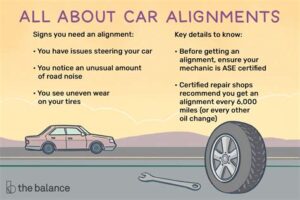Discover the essentials of car alignment, its maintenance importance, signs of misalignment, frequency checks, and the benefits of regular alignment for optimal driving.When it comes to maintaining your vehicle’s efficiency and safety, car alignment is a crucial aspect that often goes overlooked. Proper alignment ensures that your tires meet the road at the correct angle, promoting balanced wear and improving handling. In this blog post, we will explore what car alignment entails, why it’s vital for your vehicle’s performance, and how to identify signs of misaligned wheels. Additionally, we’ll provide recommendations on how often you should check your alignment and the numerous benefits that come from regular maintenance. Whether you’re a seasoned car owner or a new driver, understanding the significance of alignment will help you keep your vehicle running smoothly and safely on the road. Let’s dive into the essentials of car alignment and ensure your ride is always in top shape!
Understanding Car Alignment
Car alignment, often referred to as wheel alignment, involves adjusting the angles of the wheels so that they are parallel to each other and perpendicular to the ground. Proper alignment ensures that the vehicle handles effectively and that the tires wear evenly. Misalignment can lead to various problems, including poor handling, increased tire wear, and even a decrease in fuel efficiency.
When a vehicle is aligned correctly, the suspension system and steering components work in harmony, allowing for a smooth ride and responsive steering. The alignment is measured in terms of three primary angles: camber, caster, and toe. Each of these components plays a crucial role in the overall driving experience.
Regular checks and maintenance of your car’s alignment are essential to prolonging the life of your tires and ensuring a safe driving experience. Ignoring alignment issues can lead to serious safety concerns and costly repairs down the line.
Importance of Alignment Maintenance
Maintaining proper alignment of your vehicle’s wheels is crucial for its overall performance and safety. Wheel alignment refers to the adjustment of the angles of the wheels so that they are perpendicular to the ground and parallel to each other. When alignment is compromised, it can lead to premature tire wear, decreased fuel efficiency, and a diminished driving experience.
Regular alignment maintenance not only ensures a smoother ride but also extends the lifespan of your tires. Having well-aligned wheels can enhance the vehicle’s handling, making it easier to steer and providing a more stable driving experience. Moreover, good alignment helps maintain optimal contact between the tires and the road, improving traction and ensuring better safety.
Ignoring alignment issues can result in significant costs down the line, as tires can wear unevenly or become damaged, leading to the need for costly replacements. Therefore, investing time and resources into maintaining proper alignment is not just advisable; it’s a necessity for any vehicle owner.
Signs of Misaligned Wheels
Understanding the signs of misaligned wheels is crucial for maintaining your vehicle’s performance and safety. If your car’s wheels are out of alignment, you can experience a variety of symptoms that can lead to more significant problems if not addressed.
Here are some common indicators of misaligned wheels:
- Uneven Tire Wear: If you notice that your tires are wearing unevenly, it could be a sign that your wheels are misaligned. Check for tread wear patterns that are inconsistent across the tires.
- Pulling to One Side: If your vehicle tends to drift or pull to one side while driving, this could indicate that the wheels are not aligned correctly.
- Steering Wheel Off-Center: A steering wheel that is not centered when driving straight is another common sign of misalignment. This misalignment can lead to difficulty steering and increased risk on the road.
- Vibration or Shaking: If you feel vibrations or shaking through the steering wheel, it may be a sign of larger issues, including misalignment.
Understanding these signs of misaligned wheels can help you identify issues early and prevent further damage to your vehicle. If you notice any of these symptoms, it’s essential to have your alignment checked by a professional mechanic.
Frequency of Alignment Check
Understanding how often you should check your car’s alignment is crucial for maintaining optimal vehicle performance and safety. Typically, it’s advisable to have your car alignment checked every 6,000 miles or once a year, whichever comes first. However, this frequency can vary based on driving conditions and habits.
For instance, if you frequently drive on rough roads or encounter potholes, your alignment may need checking more often. Additionally, if you’ve recently experienced suspension repairs or had new tires installed, a prompt alignment check is essential to ensure even tire wear and proper handling.
Regularly checking your alignment not only helps in maintaining tire health but also enhances fuel efficiency, contributing to a smoother driving experience. By understanding the recommended frequency for alignment checks, you can ensure your vehicle remains in top shape for the road ahead.
Benefits of Regular Alignment
Regular car alignment is vital for maintaining the performance and safety of your vehicle. When your wheels are properly aligned, it enhances your driving experience and prolongs vehicle lifespan. Some of the most significant benefits of regular alignment include:
- Improved Handling: One of the main benefits of a well-aligned car is enhanced handling. You will notice that your vehicle responds better to steering inputs and corners smoothly.
- Increased Tire Life: Misalignment can lead to uneven tire wear. With proper alignment, you maximize the lifespan of your tires, reducing the need for frequent replacements.
- Better Fuel Efficiency: A correctly aligned vehicle requires less energy to move forward. This efficiency translates into better fuel economy, saving you money at the pump.
Additionally, keeping your wheels aligned can prevent other wear-and-tear on your vehicle components, such as suspension and steering systems, potentially saving you expensive repair bills in the long run.
It’s clear that the benefits of regular alignment extend beyond just being able to steer straight. Prioritizing alignment checks as part of routine maintenance ensures that your vehicle remains in top shape, safeguarding both performance and safety.
In summary, regular alignment checks bring multiple benefits that contribute to a safer and more efficient driving experience. Don’t underestimate the importance of keeping your wheels align
Frequently Asked Questions
What is car alignment?
Car alignment refers to the adjustment of a vehicle’s suspension system, ensuring that the wheels are set to the optimal angle and position for proper handling and tire wear.
How often should I get my car aligned?
It’s generally recommended to have a car alignment check every 6,000 miles or at least once a year, but you should also inspect it after any major impact, like hitting a pothole.
What are the signs that my car needs an alignment?
Common signs include uneven tire wear, the steering wheel pulling to one side, a crooked steering wheel when driving straight, and a general decrease in handling stability.
Does tire rotation affect car alignment?
While tire rotation itself does not affect car alignment, maintaining proper tire wear through regular rotations can help identify alignment issues sooner.
Can I check my car’s alignment at home?
While you can perform a visual inspection and look for uneven tire wear or misaligned steering, a professional alignment check requires specialized equipment that is typically only available at auto shops.
How much does a car alignment typically cost?
The cost of a car alignment usually ranges from $75 to $100, but prices can vary based on location and vehicle type.
Is it safe to drive a car with misaligned wheels?
Driving a car with misaligned wheels can compromise safety by affecting handling, increasing tire wear, and potentially leading to more serious mechanical issues.





